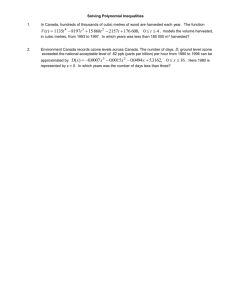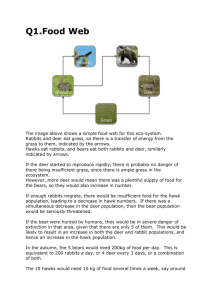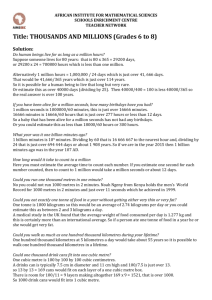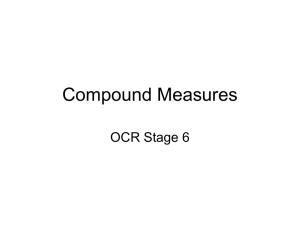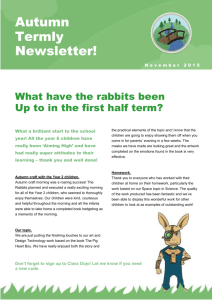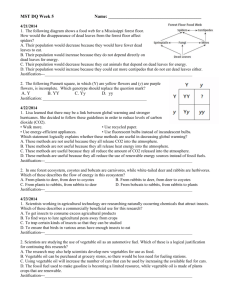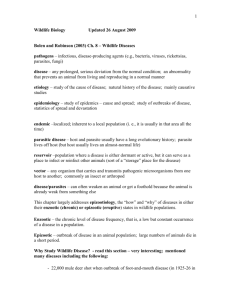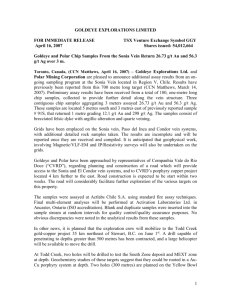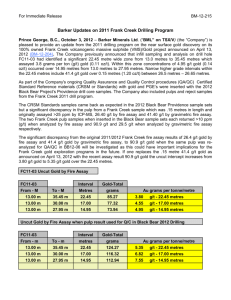Problem-Solving-Estimation Q1. A simple ecosystem consists of
advertisement
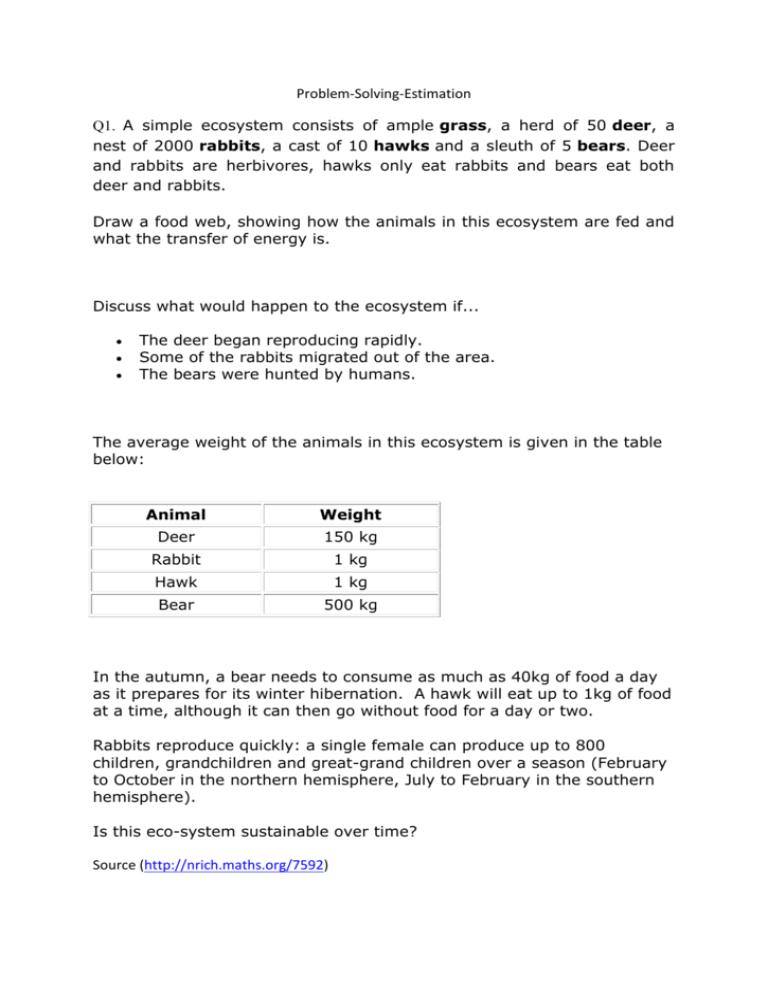
Problem-Solving-Estimation Q1. A simple ecosystem consists of ample grass, a herd of 50 deer, a nest of 2000 rabbits, a cast of 10 hawks and a sleuth of 5 bears. Deer and rabbits are herbivores, hawks only eat rabbits and bears eat both deer and rabbits. Draw a food web, showing how the animals in this ecosystem are fed and what the transfer of energy is. Discuss what would happen to the ecosystem if... The deer began reproducing rapidly. Some of the rabbits migrated out of the area. The bears were hunted by humans. The average weight of the animals in this ecosystem is given in the table below: Animal Weight Deer 150 kg Rabbit 1 kg Hawk 1 kg Bear 500 kg In the autumn, a bear needs to consume as much as 40kg of food a day as it prepares for its winter hibernation. A hawk will eat up to 1kg of food at a time, although it can then go without food for a day or two. Rabbits reproduce quickly: a single female can produce up to 800 children, grandchildren and great-grand children over a season (February to October in the northern hemisphere, July to February in the southern hemisphere). Is this eco-system sustainable over time? Source (http://nrich.maths.org/7592) A scientist makes a set of estimates of various physical quantities. Can you work out how the scientist made her estimates by reproducing the calculations? Do the answers sound about right, or has the scientist made any significant mistakes? 1. A bottle of water contains 500cm3 of liquid. I fill a crate measuring 1m by 50cm by 50cm with bottles of water to take on a field trip. I estimate that the crate contains 500 bottles of water. 2. The number of rings a tree has on its trunk can tell you how old it is. On a tree stump I measure the distance between two adjacent rings and find that it is 0.6cm. The diameter of the stump is almost half a metre. I estimate that the tree was 42 years old when it was cut down. 3. Today I ate a 30g packet of crisps at morning break time, as I always do, so I estimate that I eat almost 11kg of crisps a year. 4. A packet of sugar weighs 1kg. My friend and I take two spoons of sugar in our coffee and we each drink 4 cups per day. One packet should just about last us for the two month field trip that we are planning. 5. My round trip to work each day is about 22 miles, but I can claim mileage from work. I estimate that I can claim for 8000 miles each year. 6. Last month the energy costs in my lab were £560. I estimate that my energy costs per year will be £7000. 7. I have a large mound of building rubble which needs disposing of. The mound is about 2 metres high in the middle and about 3 metres across. I estimate that there is about 4.7 cubic metres of rubble which needs to be removed, so I should be safe ordering a 5 cubic metre skip. 8. A very large waterfall measures 170 metres across. I measure the flow rate in the centre and it is 124 cubic metres of flow per metre per minute. I estimate that 632 metric tonnes of water flows over the waterfall per hour. 9. My vegetable plot for testing variations of plants measures 9.5 by 11 metres. I test two square metres of ground and find 53 worms in one section and 42 worms in the other. I estimate a population of 5000 worms in the vegetable plot. (http://nrich.maths.org/7418) Have a look at the sets of four quantities below. Can you rank them in order from smallest to largest? To help you to decide on your rankings, you may need to find extra information or carry out some experiments. Can you provide convincing evidence of your final rankings? Time For light to reach us from the nearest star other than the sun That a pet rat lives Between two football world cups For all of the red blood cells in your body to be replaced....10 times Distance You can hop in 5 seconds A car can drive on 1cm3 of fuel From the top of a 6 storey building to the ground The distance from the penalty spot to the goal on a football field Speed Of Of Of Of a racehorse running at maximum speed the fastest sprinter in the world the fastest cyclist in an Olympic cycle sprint race a bus going past the school Mass Of a standard family car Of a million cubic centimetres of water Of a team of international male rugby players (15 players) Of enough potatoes to make chips to feed everyone in the school for a week. Volume of water In a half-filled bath Used in a 10 minute shower Used in 5 dishwasher cycles Used to flush the toilet 20 times Number of Mars bars with the same total weight as your whole class Steps when walking at a leisurely pace for 1 hour Stitches in a handknitted jumper People at a cup final in a large stadium Area Of the sheets of paper in a ream (500 sheets) of A4. Of the floor of the classroom Covered by 5 litres of paint Of fabric needed to make school uniforms for the whole class. Perhaps you might like to make 4 ranked quantities of your own to challenge a friend. (http://nrich.maths.org/7500) Biology makes good use of numbers both small and large. Try these questions involving big and small numbers. You might need to use standard biological data not given in the question. Of course, as these questions involve estimation there are no definitive 'correct' answers. Just try to make your answers to each part as accurate as seems appropriate in the context of question. 1. Estimate how many breaths you will take in a lifetime. 2. Estimate the number of people who live within 1 km of your school. 3. I look through a microscope and see a cell with a roughly circular cross section of 7 microns. Estimate the volume of the cell. 4. The arctic tern migrates from the antarctic to the arctic. Estimate how far an arctic tern flies in its lifetime. 5. Estimate the weight of dog food eaten in England each year. 6. An amoeba doubles in size every 24 minutes. How long will a sample of size about 1mm by 1mm take to cover a petri dish? Do we need to worry too much about the initial size of the sample in this calculation? 7. Estimate how many cells there are in your little finger 8. Estimate the total weight of the pets of everyone in your class 9. How much do you think your brain weighs? How much do you think this weight varies over the course of your life? 10. If current trends continue what will the population of the UK be in ten years' time? Do you think it is reasonable to assume that they will continue? Why? (http://nrich.maths.org/7275)

